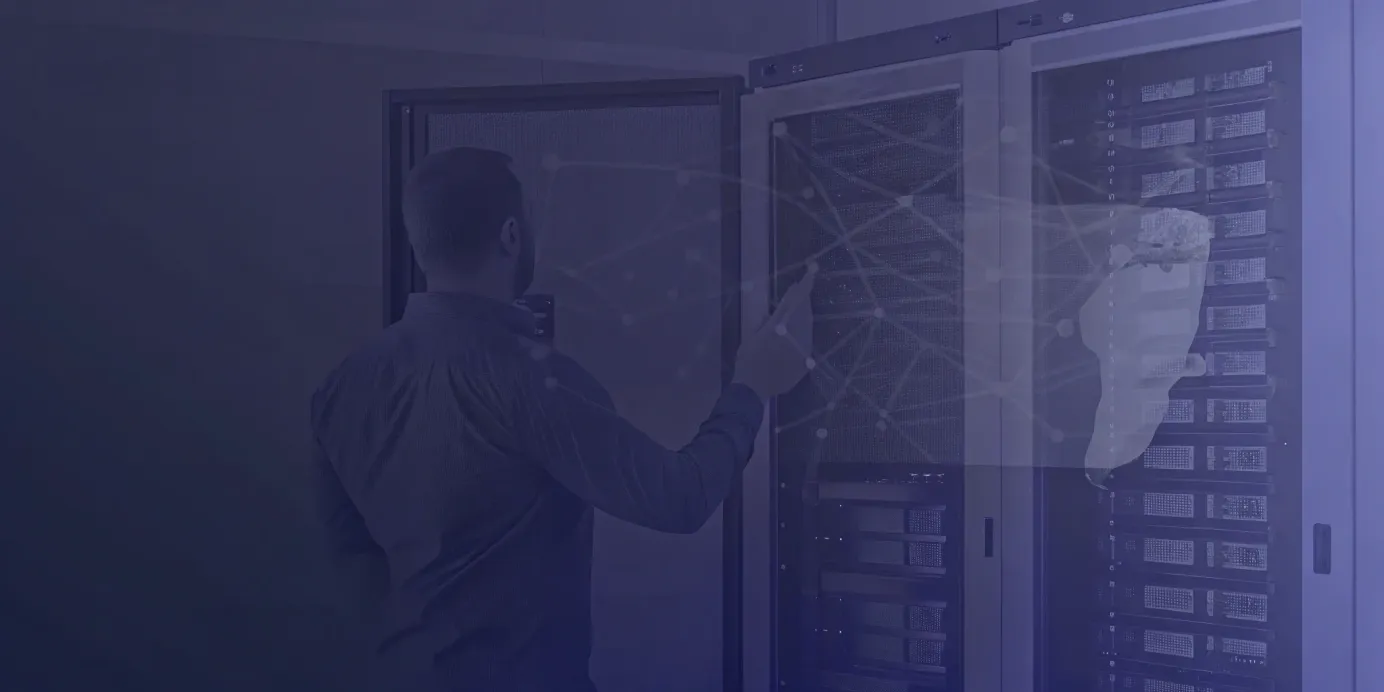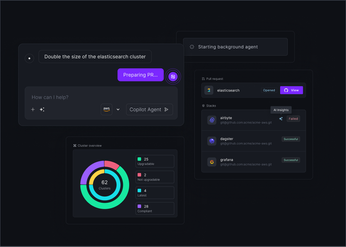
Agent-Based Kubernetes Deployments: A Practical Guide
Get a clear, practical overview of agent-based Kubernetes deployment, including architecture, security, and best practices for managing clusters at scale.
Managing Kubernetes clusters across multiple clouds, on-premises data centers, and edge environments is inherently complex. Networking alone (balancing VPNs, VPC peering, and firewall configurations) can become a major operational bottleneck, often making it impossible to maintain unified visibility and control.
An agent-based deployment model addresses this challenge by reversing the connection flow. Instead of exposing clusters to inbound management traffic, lightweight agents within each cluster initiate secure outbound connections to a central control plane. This pull-based architecture eliminates complex networking dependencies while maintaining strong security boundaries.
The result is a truly centralized management experience—a single, secure control plane that offers consistent policy enforcement, monitoring, and orchestration across all clusters, regardless of where they run.
Unified Cloud Orchestration for Kubernetes
Manage Kubernetes at scale through a single, enterprise-ready platform.
Key takeaways:
- Improve security by isolating your clusters: An agent-based, pull model uses egress-only communication, eliminating the need for inbound ports on your workload clusters. This design reduces the attack surface and simplifies compliance by keeping credentials local to each cluster.
- Manage large, distributed fleets from a single control plane: The agent architecture allows you to consistently manage clusters across any environment—multi-cloud, on-prem, or edge—without complex networking. This centralizes configuration while delegating execution to each cluster.
- Achieve reliable automation with GitOps and agents: By using Git as the source of truth, agents act as the enforcement mechanism in each cluster. This creates an auditable, version-controlled workflow that automatically detects and corrects configuration drift, ensuring consistency.
What Is Agent-Based Kubernetes Deployment
An agent-based Kubernetes deployment uses a lightweight process (called an agent) that runs inside each cluster to perform management and synchronization tasks. Each agent securely connects to a central control plane to pull configurations, apply updates, and report cluster state. This architecture is purpose-built for large, distributed Kubernetes environments, providing a scalable and secure management model that doesn’t rely on exposing cluster APIs or centralizing credentials. By shifting execution to the edge, it enables greater autonomy, fault tolerance, and resilience across your entire fleet.
Understanding the Core Architecture
An agent-based model is composed of two key components: a central control plane and cluster-level agents. The control plane maintains the desired state for all managed clusters and acts as the authoritative configuration source. The agent—running as a pod within each workload cluster—executes local operations such as applying manifests, synchronizing resources, or running infrastructure-as-code workflows.
In Plural, this model is implemented with a control plane hosted in a management cluster and lightweight deployment agents installed across workload clusters. This separation ensures the control plane handles orchestration and policy, while agents perform secure, localized execution. The result is centralized governance without sacrificing isolation or flexibility.
Why a Pull-Based Model Is Better
Push-based models rely on central controllers with direct network access and powerful credentials to each cluster, introducing significant security and operational risks. A pull-based architecture reverses this relationship—agents initiate outbound connections to the control plane, retrieving configurations and updates as needed.
This design removes the need for inbound access or shared credentials, allowing clusters to remain fully private. Because the control plane only serves configurations when requested, it scales effortlessly across thousands of clusters. This is the foundation of Plural CD, which leverages a secure, pull-based agent system to manage fleets at any scale with minimal overhead.
How Isolation Improves Security
Isolation is a built-in security advantage of the agent-based model. Each agent runs within its own cluster’s context, using scoped local credentials such as Kubernetes ServiceAccounts to apply changes. There is no global credential store or central access token that could expose the entire environment if compromised.
If a single agent is breached, the impact is contained to that specific cluster. This principle of decentralized execution—centralized control with local enforcement—is core to Plural’s security model. It also simplifies compliance with strict regulatory frameworks like FedRAMP, which require strong network isolation and least-privilege access across distributed systems.
What Are the Core Components
An agent-based Kubernetes architecture is built around two fundamental components: a central control plane and distributed agents running on individual clusters. The control plane defines and stores the desired state of your fleet, while each agent is responsible for pulling configurations and applying them locally. This separation of concerns allows for secure, scalable, and consistent management across diverse environments. The control plane dictates what should happen, and the agents determine how to execute those changes within their respective clusters.
The Control Plane’s Role
The control plane acts as the central intelligence of an agent-based deployment model. It maintains the desired state for all clusters, schedules workloads, and orchestrates resource scaling. It aggregates configuration from declarative sources—most commonly Git repositories—and distributes this state to agents.
In Plural, the control plane is deployed as a full-stack service on a management cluster. It includes a horizontally scalable Git cache, a configuration management backend, and integrated Cluster API providers to manage cluster lifecycles. This architecture ensures all configuration and state management are centralized and auditable, giving teams a consistent, single source of truth across environments.
Agent Communication Patterns
In a pull-based architecture, all communication originates from the agents. Each agent periodically contacts the control plane to retrieve configuration updates or deployment instructions. This unidirectional flow—outbound from agent to control plane—is a key security advantage.
Because the control plane never initiates inbound connections, workload clusters can remain completely private without exposing network ports. Plural’s deployment agent follows this egress-only pattern, maintaining a secure, encrypted channel for communication. This design minimizes networking overhead, simplifies firewall policies, and reduces the overall attack surface, making it compliant with stringent security standards.
How to Manage State
In distributed systems, managing state consistently is critical. While Kubernetes provides mechanisms like StatefulSets for application-level persistence, infrastructure state in an agent-based model is managed declaratively through GitOps principles. The desired infrastructure state is stored in code, typically in Git, and the control plane serves this configuration to agents.
Agents continuously reconcile the cluster’s actual state with the desired one, ensuring consistency without manual intervention. Plural Stacks extend this model by integrating Infrastructure-as-Code (IaC) tools such as Terraform behind a consistent API, allowing teams to manage both infrastructure and applications using the same declarative workflow.
Defining Resource Requirements
Resource tuning is essential for performance and reliability. Each system component—including deployment agents—must have clearly defined CPU and memory requests and limits. Over- or under-provisioning can lead to resource contention or instability across the fleet.
The Plural deployment agent is intentionally lightweight, designed to run efficiently without consuming significant cluster resources. Despite its small footprint, it is powerful enough to handle configuration polling, manifest application, and synchronization tasks reliably. This balance of simplicity and efficiency reduces operational overhead while ensuring consistent, predictable behavior across all managed clusters.
How to Implement an Agent-Based Model
Implementing an agent-based Kubernetes architecture requires a structured approach that balances automation with operational awareness. In this model, deployment logic resides within agents running inside each cluster. These agents pull configurations from a central control plane, enabling secure, scalable management across distributed environments.
While platforms like Plural automate most of the setup and lifecycle management, understanding the core workflow helps you maintain control and troubleshoot effectively. The following sections outline the key steps for deploying, securing, and monitoring agents to build a resilient, production-grade system.
Get Started: Prerequisites and Setup
Before deploying agents, ensure your environment meets the baseline requirements. You’ll need:
- A functioning Kubernetes cluster (version 1.26 or newer recommended)
- Access to kubectl and Helm for cluster interaction and package management
- Sufficient CPU and memory headroom for running the agent alongside workloads
For manual setups, you can provision resources and install components directly. However, Plural streamlines this process. When you register a new cluster, Plural automatically validates your environment and provisions the deployment agent in a properly configured namespace, eliminating most manual setup work.
Configure Your First Deployment
Once the environment is ready, the next step is deploying the agent. The standard approach is to use a Helm chart, which bundles the agent manifests and configuration files. A typical command might look like:
helm install plural-agent plural/agent \
--set controlPlane.url=https://control-plane.example.com \
--set auth.token=<your-token>
This registers the agent with the control plane, allowing it to start pulling configurations and executing tasks locally. In Plural, this process is automated: connecting a new cluster automatically triggers agent installation and configuration, removing the need for manual token handling or Helm commands.
Apply Security Best Practices
Security must be integrated from the start. Each agent should have defined resource requests and limits to prevent contention or eviction, as well as liveness and readiness probes to ensure Kubernetes can self-heal agent pods.
The agent-based model inherently improves security by using egress-only communication—agents connect outward, so clusters don’t need exposed APIs or inbound network rules. Plural extends this with a zero-trust design: agents use local credentials for all write operations, so no high-privilege secrets are stored in the control plane. This minimizes the blast radius of any potential breach and simplifies compliance with strict frameworks.
Monitor and Verify the Deployment
Once the agent is deployed, you must confirm it’s functioning correctly and continuously monitor its performance. Basic checks include verifying pod status and reviewing logs via kubectl get pods and kubectl logs. For long-term operations, track metrics like:
- CPU and memory consumption
- Network bandwidth and request latency
- Synchronization frequency with the control plane
While you can integrate Prometheus and Grafana for visibility, Plural eliminates this complexity by embedding observability directly into its control plane dashboard. You get real-time visibility into agent health, deployment progress, and synchronization status across all clusters—providing a single, unified view of your fleet without maintaining a separate monitoring stack.
How to Optimize Agent Performance
Once your agents are running, maintaining peak performance becomes an ongoing operational priority. Optimization ensures that agents remain efficient, resilient, and responsive, especially as your Kubernetes footprint scales. Poorly tuned agents can slow down deployments, introduce synchronization lag, or even distort the state of your clusters. A well-optimized agent, by contrast, acts as a lightweight, invisible extension of your control plane—stable under load and efficient in resource usage.
Key areas to focus on include resource management, update strategies, performance tuning, and troubleshooting. Each plays a crucial role in sustaining high availability and operational consistency across your entire fleet. Plural’s agent architecture is designed for efficiency, but these best practices help you maximize its potential in real-world conditions.
Manage Agent Resources Effectively
Resource allocation is the foundation of agent stability. Misconfigured CPU or memory requests and limits are common pitfalls that can lead to unpredictable scheduling or service disruptions. Without defined requests, the Kubernetes scheduler can’t optimize pod placement. Without limits, runaway agents risk starving other workloads.
Start by profiling the agent’s typical resource consumption under normal conditions. Set CPU and memory requests slightly above that baseline, then refine these values over time using live metrics. If an agent is consistently throttled, increase its CPU limit. If it restarts due to OutOfMemory errors, allocate additional memory.
Plural’s dashboard simplifies this process by exposing real-time agent metrics, allowing you to tune performance without guesswork. This is especially valuable in large-scale environments where deployment frequency and workload diversity can cause fluctuating demand.
Plan Your Update Strategy
Keeping agents current is essential for maintaining both performance and security. Outdated agents can introduce compatibility issues with Kubernetes APIs or control plane components. A disciplined update strategy ensures your fleet remains stable through version transitions.
The best practice for large environments is a phased rollout, starting with a few canary clusters to validate each new agent release before expanding it fleet-wide. Automating this process reduces operational overhead and risk.
Plural CD manages agent updates automatically, enforcing version consistency and applying updates declaratively. This ensures every cluster runs the right agent version in sync with the control plane—no manual tracking, no configuration drift.
Tune for Better Performance
Default agent configurations are suitable for most clusters, but advanced tuning can unlock better performance in large or high-frequency deployment environments.
One critical parameter is the polling interval, which determines how often the agent checks for new configurations. A shorter interval minimizes deployment latency but increases network chatter and control plane load. Adjust it to balance responsiveness with scalability.
Similarly, concurrency settings define how many reconciliation tasks the agent performs simultaneously. Raising concurrency can accelerate updates in clusters with thousands of resources, but it also increases CPU and memory usage. Tune these parameters gradually, monitoring system behavior to maintain stability.
Troubleshoot Common Issues
When agents fail or perform inconsistently, observability is key to identifying the root cause. Typical issues include:
- Network connectivity errors preventing agent-to-control-plane communication
- Insufficient RBAC permissions blocking resource updates
- Configuration drift or malformed manifests
- CrashLoopBackOff states caused by memory exhaustion or misconfiguration
Start by reviewing the agent logs with kubectl logs, then verify connectivity and permissions. Plural’s centralized dashboard streamlines troubleshooting by surfacing all relevant data—logs, health checks, and metrics—within a single interface. Its built-in authentication proxy maintains secure, on-demand access to agents across both cloud and on-prem environments.
This unified observability layer eliminates the need to juggle multiple kubeconfigs, reducing mean time to resolution and keeping your agent-based deployment pipeline running smoothly.
Advanced Deployment Strategies
Once your agent-based deployment model is stable, you can extend it with advanced strategies to improve automation, scalability, and operational resilience. These approaches help you handle complex, distributed environments—from multi-cluster fleets to remote edge deployments—while preserving control and consistency. By layering these techniques onto your existing architecture, you can evolve your agent-based system into a scalable, GitOps-driven continuous delivery pipeline that meets enterprise reliability standards.
Integrate with GitOps Workflows
GitOps provides a natural complement to the agent-based model by making Git the single source of truth for both infrastructure and applications. Instead of pushing updates, agents pull the desired state from Git through the control plane, ensuring the live environment always matches what’s defined in code.
Every modification is a versioned commit, every deployment is traceable, and every rollback is as simple as reverting a Git change. This enables a declarative, auditable, and reviewable delivery process where changes are validated through pull requests before being applied.
Plural CD is built around these GitOps principles, automating pull requests for infrastructure and application updates. By integrating GitOps with the agent architecture, you gain a unified, version-controlled pipeline where every environment can be reproduced with precision.
Manage Fleets with Multi-Cluster Support
As your organization expands, managing dozens or even hundreds of Kubernetes clusters across multiple clouds and on-prem environments becomes a significant challenge. The agent-based model simplifies this through its pull-based communication pattern—each agent initiates outbound connections to the control plane, eliminating the need for inbound access, VPNs, or peering configurations.
This architecture allows you to securely manage fleets of clusters, even when they reside behind strict network perimeters. Plural’s control plane provides centralized visibility and lifecycle management across all clusters, giving teams a single interface for deployments, monitoring, and updates—without compromising network isolation or compliance requirements.
Streamline Configuration Management
Maintaining consistent configuration across clusters is a common source of operational drift. In an agent-based model, configuration management is centralized through the control plane, which distributes and enforces environment-specific settings.
You can use Kubernetes-native resources such as ConfigMaps and Secrets—all defined declaratively in your Git repository—to manage variables, credentials, and feature flags across environments. Plural’s configuration management layer enhances this further, allowing you to parameterize deployments, inject secrets securely, and synchronize configurations seamlessly across all managed clusters.
This approach reduces manual overhead, minimizes configuration drift, and ensures all environments stay synchronized with your organization’s standards.
Set Up Automated Drift Detection
Configuration drift—when a cluster’s actual state diverges from the desired state—is one of the leading causes of instability in distributed systems. Agents solve this problem by continuously reconciling each cluster’s live configuration with the version stored in Git.
If drift is detected, the agent can alert operators or automatically correct the deviation to restore compliance. This reconciliation loop ensures that every cluster remains aligned with the source of truth, even in the face of manual changes or transient failures.
Plural CD automates this process entirely, continuously monitoring for drift and reconciling changes in real time. The result is a self-healing deployment model where every cluster maintains its intended configuration with minimal human intervention.
How to Scale and Manage Your Agents
As your Kubernetes footprint grows, managing the lifecycle of hundreds or even thousands of agents becomes a scaling challenge. You need a strategy that handles automated deployment across environments, integrates with your existing tooling, and provides visibility into health and performance—all without introducing new operational overhead.
Plural’s agent-based model is built for this kind of scale. Each agent runs as a lightweight, self-managing component that connects out to a central control plane, making it easy to deploy, monitor, and maintain at any scale. The key is to treat these agents as core infrastructure components—automate their lifecycle, right-size their resources, and design for resilience so the system keeps running even when individual agents fail.
Deploy Agents at the Edge
Edge environments—like retail stores, factory floors, or branch offices—introduce constraints that don’t exist in the cloud. Connectivity may be intermittent, compute resources are often limited, and local autonomy is essential.
In these cases, the agent needs to be lightweight, resilient, and able to operate offline. Plural’s deployment agent is just that: a small binary that polls the control plane for updates and applies them locally. If the network drops, the agent keeps running workloads using the last known configuration until it reconnects.
This pull-based pattern is ideal for edge scenarios—no inbound connectivity required, no complex VPNs, and no dependency on persistent connections.
Integrate with Cloud-Native Tooling
Your deployment agents should integrate cleanly with the rest of your Kubernetes ecosystem. That includes autoscalers, secrets managers, and service meshes—anything that helps your clusters stay performant and secure.
Plural’s API-driven architecture makes this straightforward. Using Plural Stacks, you can declaratively define add-ons like Prometheus, Vault, or Istio alongside your application manifests. The agent executes these IaC (infrastructure-as-code) runs on the target cluster, ensuring everything from monitoring to service discovery is deployed consistently.
By embedding your tooling into the same workflow as your apps, you reduce drift and eliminate one-off setup scripts.
Build a Monitoring and Observability Stack
You can’t debug what you can’t see. When running agents across multiple clusters, you need centralized insight into what they’re doing—status, health, resource usage, and sync state.
Plural’s console provides a single-pane-of-glass view across all managed clusters. It surfaces metrics, agent activity, and cluster health through a secure, egress-only connection—meaning you can observe on-prem and private clusters without exposing them to the internet.
For deeper visibility, integrate with Prometheus or Grafana to track CPU, memory, and reconciliation metrics at the agent level. This helps teams detect issues like stuck reconciliation loops, failed deployments, or unavailable nodes before they escalate.
Ensure High Availability
High availability (HA) is table stakes for production systems. Your agents and control plane must tolerate failures without interrupting workloads or breaking delivery pipelines.
Plural’s pull-based design inherently supports HA. Because agents are decoupled from the control plane, clusters keep running even if the control plane goes offline. Agents are also stateless and self-healing—if one crashes, Kubernetes restarts it automatically.
This architecture removes single points of failure and ensures your deployment infrastructure remains resilient under load or partial outages.
Security and Compliance
An agent-based architecture naturally strengthens your Kubernetes security posture, but it still requires a disciplined approach to network hardening, access control, and auditing. The pull-based model minimizes your exposure by eliminating inbound connectivity from the internet—agents inside each cluster pull configurations from the control plane instead of the control plane pushing them in. This inversion of control simplifies security at scale while maintaining flexibility and developer autonomy.
Plural’s architecture builds on these security principles, combining strong isolation with centralized governance. By separating the control plane from workload clusters, you can enforce consistent policies, manage access uniformly, and maintain a complete audit trail across your entire fleet.
Harden Your Network Security
The biggest advantage of an agent-based model is its network architecture. In Plural, agents initiate all communication with the control plane via egress-only HTTPS connections. This means your clusters don’t need any inbound exposure—no open ports, no VPN tunnels, and no firewall exceptions. As a result, clusters can stay completely private while remaining fully manageable.
Still, securing outbound communication is just the foundation. Inside the cluster, you should enforce Kubernetes NetworkPolicies to restrict pod-to-pod traffic and follow a zero-trust model. This ensures that even if one component is compromised, lateral movement is limited. Combined with private networking and TLS-encrypted communication, this setup dramatically reduces both external and internal attack vectors.
Implement Role-Based Access Control
Access control in a distributed agent model happens at two levels:
- User access to the control plane
- The agent’s permissions within the target cluster
The agent should follow the principle of least privilege, granting only the minimal permissions necessary to reconcile deployments and manage resources.
For user management, Plural integrates directly with your identity provider (IdP) and uses Kubernetes Impersonation to map user identities from the Plural console to cluster-level RBAC roles. This provides a seamless SSO experience—users authenticate once, and their permissions are automatically enforced on each cluster.
You can also manage RBAC policies declaratively via GitOps. Defining roles and bindings in Git ensures consistent, auditable, and version-controlled access management across all clusters.
Configure Audit Logging
Visibility and traceability are critical for compliance and incident response. In an agent-based architecture, you have three complementary audit layers:
- Control Plane Logs — Record every API request and deployment action, including who initiated them and when.
- GitOps Repository History — Provides an immutable log of configuration and infrastructure changes.
- Kubernetes Audit Logs — Capture all API calls made by the agent in the target cluster, giving a granular view of in-cluster operations.
Combining these logs provides an end-to-end trace from user intent to actual cluster change, simplifying investigations and compliance audits.
Meet Key Compliance Standards
If your organization operates under frameworks like HIPAA, PCI DSS, or FedRAMP, agent-based systems can make compliance far more manageable. The architecture inherently satisfies many of these frameworks’ core principles—network segmentation, controlled access, and verifiable change history.
Plural’s egress-only communication model aligns with strict network perimeter rules, while its centralized RBAC and audit trail capabilities simplify compliance reporting. You can further strengthen this by integrating OPA Gatekeeper or Kyverno to enforce security and compliance policies declaratively—preventing misconfigurations before they ever reach production.
Related Articles
Unified Cloud Orchestration for Kubernetes
Manage Kubernetes at scale through a single, enterprise-ready platform.
Frequently Asked Questions
How does an agent-based model actually improve security compared to traditional CI/CD pipelines? Traditional CI/CD pipelines often operate on a push model, requiring powerful, long-lived credentials with broad access to your entire Kubernetes fleet. These credentials, stored in the CI system, become a high-value target. An agent-based, pull model inverts this. The agent, running inside the cluster, uses a local, narrowly-scoped service account to apply changes. It initiates all communication as egress traffic to a central control plane, meaning you don't need to expose your cluster's API server to the internet. This drastically reduces the attack surface and eliminates the need for a central repository of high-privilege credentials.
What happens to my workload clusters if the central control plane becomes unavailable? The decoupling of the control plane and the agents is a key architectural benefit for resilience. If the control plane goes offline, the agents on your workload clusters will continue to run, and so will your applications. The agent will simply fail its periodic check for new configurations and retry later. The cluster's last known good state is preserved, and no running workloads are affected. This design prevents a single point of failure in the management layer from causing a fleet-wide outage.
Can this agent-based model manage more than just Kubernetes application manifests? Yes. While the primary function is often deploying Kubernetes resources, a robust agent can orchestrate a wider range of tasks. For example, Plural extends this model with a feature called Plural Stacks, which allows the agent to execute infrastructure-as-code jobs directly on the cluster. This means you can use the same secure, pull-based workflow to manage Terraform, Ansible, or Pulumi runs, ensuring that your infrastructure provisioning follows the same GitOps principles as your application deployments.
What is the resource footprint of the agent, and how does it impact my cluster's performance? The agent is designed to be a lightweight, efficient binary with a minimal resource footprint. Its primary tasks are polling a control plane, fetching configuration, and applying manifests, which are not resource-intensive operations. For most clusters, the CPU and memory consumption is negligible and will not impact application performance. It's still a best practice to set resource requests and limits for the agent pod to ensure predictable performance and prevent any potential for resource contention on constrained nodes.
How does this model handle clusters in private networks or behind strict firewalls? This is one of the primary scenarios where an agent-based model excels. Because the agent initiates all communication as outbound traffic to the control plane, it works seamlessly with clusters in private networks without requiring you to configure VPNs, bastion hosts, or complex firewall rules for inbound traffic. As long as the agent can reach the control plane via standard HTTPS, it can be fully managed. Plural's architecture uses this egress-only pattern to provide a secure way to manage and observe clusters anywhere, from on-premise data centers to the edge.
Newsletter
Join the newsletter to receive the latest updates in your inbox.









